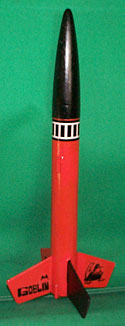| Construction Rating: | starstarstarstarstar_border |
| Flight Rating: | starstarstarstarstar |
| Overall Rating: | starstarstarstarstar |
| Manufacturer: | Estes  |
 Brief:
Brief:
OOP for many years, a single Stage, light streamer recovery, D engine mount, 4FNC rocket. This kit was provided as a free bonus by Estes if an order exceeded a certain amount.
Construction:
one BT-55 body tube, balsa nosecone, 4 balsa fins from BFS-40 fin stock (fins cut from a provided pattern, not pre-cut most of the way like they are now), D engine mount, crepe paper streamer and rubber shock cord.
Instructions were easy to follow, although with a different layout than now. The instruction sheet can be found at JimZ Rocket Plans web site. The fins are not through-the-wall, so you must either modify the cut pattern and cut the slots in the body tube; OR just build per plan and use the method of attaching wood fins proscribed by Doug Pratt on his Tomahawk. I as a 12 year old didn't do either and popped off a fin on one landing. I have since added healthy glue fillets, and painted over with orange enamel and brush.
Finishing:
The main rocket body can be spray painted either yellow like the instructions called for, or orange like I did which seemed more Halloween-ish. The decals I had are the same as on JimZ plans except for a black and white band instead of a solid black band. The nose cone and one fin are painted black.
Construction Rating: 4 out of 5
Flight:
Recommended engines are D13-5 (or C6-5, B6-4, or A8-3 with an EM2050 adapter) Obviously, Estes does not make a D13-5 any more, but the D12-5 is certainly about the same. With no added weight on the nose cone, this rocket has flown well with an A8-3, B6-4, C6-7, D12-3, and D12-5. You would think that a D would be too heavy for the rocket with no weight in nose, but I think it accelerates so quickly that it is up to speed by the time it leaves the launch rod. The estimated max height in the instructions is 1700 ft. This is probably at Colorado Springs altitude. I think mine only goes about 1000-1200 ft high on a D in Minnesota.
Recovery:
The 25 year old rubber shock cord was too brittle and failed after one flight. It was replaced by a elastic shock cord somewhat longer than the original. The crepe streamer attachment was also replaced, and a longer nylon streamer is now used.
Flight Rating: 5 out of 5
Summary:
This is only one of two vintage rockets my Mom did not throw or give away. It is responsible for my being a BAR as my Mom insisted I take it home with me one time when I was visiting. It had been kept all those years without ever flying, and flew for the first time 22 years after it had been built. Good construction technique will build lasting rockets! It is fun to bring it to club launches and show it off to the other BARs who remember it.
Overall Rating: 5 out of 5
Other Reviews
- Estes Goblin By Bill Eichelberger
Brief: By the early '70s, the Estes catalog had expanded from its Astron roots to the point that it pretty well covered the whole range of the model rocketry spectrum. The available rockets ranged from unique scale birds such as the Pershing 1A and the Nike-Ajax, to now legendary futuristic kits like the Orbital Transport, Interceptor and Mars Lander. Another segment that Estes began to ...
 |
 |
Flights
 |
 |